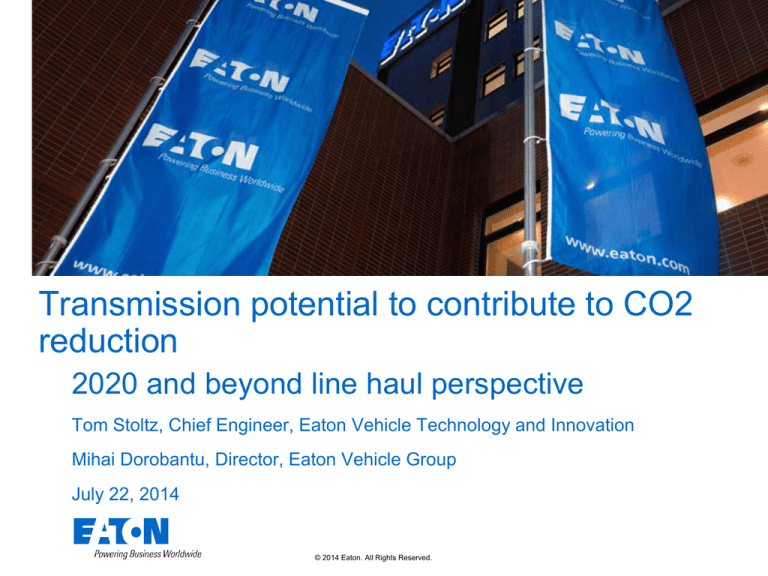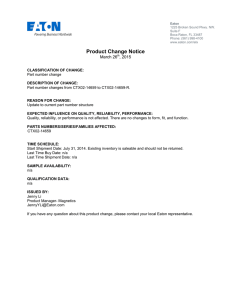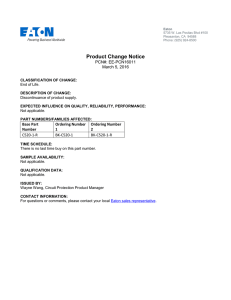
Transmission potential to contribute to CO2
reduction
2020 and beyond line haul perspective
Tom Stoltz, Chief Engineer, Eaton Vehicle Technology and Innovation
Mihai Dorobantu, Director, Eaton Vehicle Group
July 22, 2014
© 2014 Eaton. All Rights Reserved..
HD Transmission Technology Trends
Complexity / Performance
Higher performance and complexity and deep integration
Integration
You
are
here
CVT?
EV?
Look-ahead
Hybrid?
DCT
MT
AMT
Manual
Automated
Optimization
Evolution
Revolution
Time
© 2014 Eaton. All Rights Reserved..
3
Transmission Optimization
Still opportunity to improve component efficiency
• In-Gear efficiency [0.5%-1%]
• Dry sump & lubricants [1%]
• Bearing losses [.25%]
• Light weighting is important:
Potential to eliminate 300-500 lbs
drives 0.3-0.5% fuel and 1% –
1.5% freight efficiency
-
Architecture
-
Materials (shafts and gears 60% of gearbox weight)
40% weight red.
30% weight red.
Steel torque carrying elements
Lightweight filling (polymer/C-fiber or Al)
© 2014 Eaton. All Rights Reserved..
4
Automation
Transition from Manual to AMT driven by fuel economy, shift to
regional haul and driver demographics
Automated Mechanical Transmissions
•
2-4% fleet average improvement based on
average driver skill
•
Allows small ratios in high gears [1-2%]
•
Effortless shifts allow higher shift density:
key enabler to downspeeding
•
Rapid adoption in market: SmartAdvantage,
Volvo XE, DT-12. 8% in 2010, 15% in 2013,
+20% in 2014.
•
Expecting 55-60% market penetration of
AMT by 2018
© 2014 Eaton. All Rights Reserved..
Example: Eaton-Cummins
SmartAdvantage
•
Fully integrated engine &
transmission
•
3-6% improvement over base engine
(ISX 15L) and base transmission
(UtraShiftPLUS LAS)
5
Powertrain integration
Automated Mechanical Transmissions
•
AMT and mild engine downspeeding will be baseline
line haul powertrain by 2020
•
3-6% improvement is shared between engine and
transmission
Eaton-Cummins SmartAdvantage
•
3-6% improvement
•
1.5-3%: engine downspeeding from 1350
rpm to 1100 rpm at cruise
•
1.5-3%: special ratios, shift logic and
integrated controls
Dual Clutch Technology
•
reducing the power excursions in engine,
eliminating 0-torque condition at shifts [1%-3%]
•
Significantly better drivability
•
Enable further engine optimization by narrowing
operating band (eg turbo optimization)
•
Enable aggressive downspeeding due to drivability,
eg 900-1000 rpm at cruise, additional 2%
•
Lower cruise speed or higher productivity [.5-2%]
© 2014 Eaton. All Rights Reserved..
Eaton DCT proof-of-concept transmission
•
11 ratios, progressive gearing
•
Eliminate torque interrupt
•
Maintains engine at full load during shifts
•
20% faster acceleration
6
Look-Ahead technologies
Improve driver performance for fuel
economy: 3-4% fleet average
improvement
• Unique features: accounts for
•
Driver behavior
•
Real time traffic conditions
•
Non-intrusive in cabin, shaves
unnecessary acceleration peaks
• Seamless integration
•
With and without cruise control
•
Terrain and route (GPS, grade)
•
Route specifics (speed limits)
• Compatible with eco-roll type features
© 2014 Eaton. All Rights Reserved..
7
Long-term: Low-CD increases HD hybrid potential
Competing trends: eco-roll, platooning, base engine efficiency
2010
Cd
2014
2020
2025-30
0.8
0.65
0.55
0.35
522
479
450
391
MPG (65mph)
6.5
7.6
8.6
11.4
-2% grade power
-29
-72
-102
-160
HD hybrid (50% brake regen)
507
442
399
311
2% grade power
Fuel burn [gals]
Hybrid benefit
Hybrid fuel save [gals]
Hybrid fuel save $
$
13158
2.6%
336
1,343 $
8772
9.9%
867
3,468
20kWh battery pack
Today ©$10-20k,
future = $5-8k??
2014 Eaton. All Rights Reserved..
Downsize
potential
Simplifying Assumptions
50% BTE engine
Mild grades
Constant speed 65mph
80,000 lbs truck
8
Key points
Line haul entitlement: 4.5– 8% from advanced transmission, 1.5-5%
from engine, 2-4% from driver improvement and 2-10% hybrid
•
•
•
NRC 2010 study attributed 2% improvement entitlement to driveline, focused on
mechanical efficiency of gears in transmissions and axles.
•
SuperTruck and other developments relevant to 2020 timeframe go well beyond that number.
•
Preliminary 2014 NRC report recognizes potential of transmission and engine-transmission integration
but does not quantify it.
Four sources of CO2 reduction associated with transmissions
•
More efficient transmissions, minimizing mechanical losses and light weighting. [2%-3%]
•
Optimized gear rations and automation that reduces driver variability and misuse [1.5%-3%]
•
Transmission integrated with engine: enabling downsizing, downsizing, reduced engine transients,
excursions [1.5%-5%]
•
Transmission integrated with the vehicle: reducing power loss [1%-2%], hybrids [2%-10%], shifting
based on driving environment (aka making average drivers better) [2%-4%]
Key transmission technologies
•
Gearbox enhancements
•
Transition from manual to automation to dual clutch
•
Deep integration with engine enabling powertrain optimization: downspeeding and narrow-banding
engine operations
•
Integration with the driving environment: Look-Ahead
•
Hybridization and related technologies
© 2014 Eaton. All Rights Reserved..
9
© 2014 Eaton. All Rights Reserved..
10


